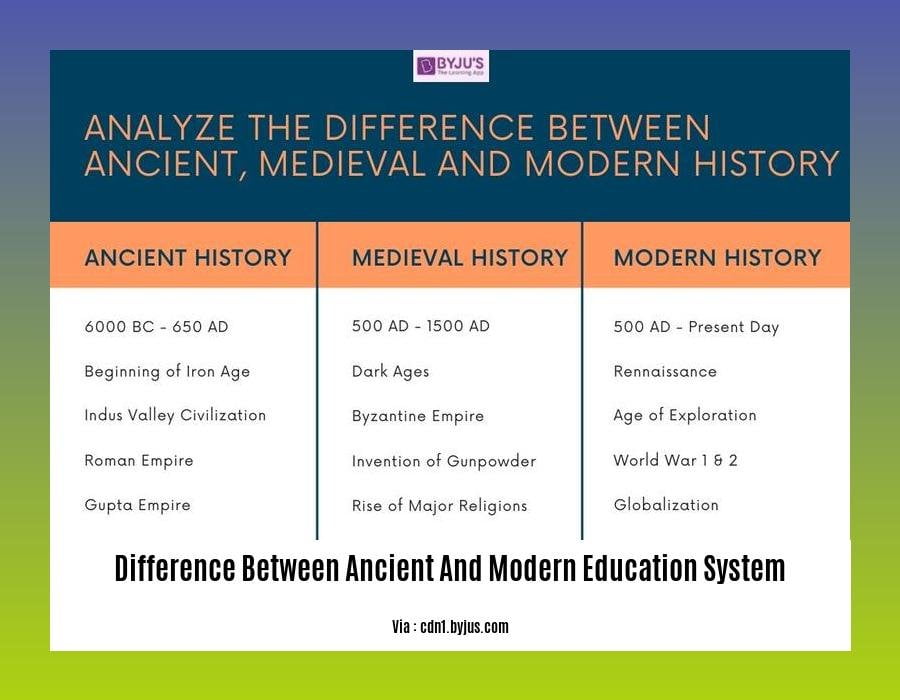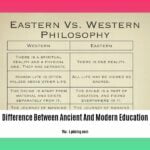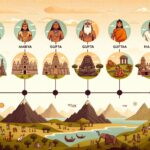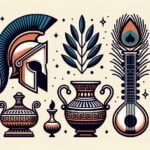Delve into the profound journey of education through time in [Exploring the Differences Between Ancient and Modern Education Systems: A Journey Through Time]. This captivating exploration unveils the stark contrasts and underlying continuities that define the evolution of learning across civilizations. Discover how ancient philosophies, methodologies, and technologies shaped the foundations of education, while modern innovations propel us into a new era of pedagogy. Unravel the evolving role of teachers, the dynamic curriculum, and the impact of societal and cultural influences that have molded education throughout history. Prepare to be enlightened as we traverse the vast landscape of educational practices, from ancient scribal schools to the digital classrooms of today.
Key Takeaways:
- Traditional Education:
- Focuses on rote memorization of facts from books and lectures.
- Emphasizes cultural values and ethics.
Limited practical learning and hands-on experiences.
Modern Education:
- Prioritizes practical learning and critical thinking skills.
- Aims to equip students with essential life skills and decision-making abilities.
Embraces technology for enhanced accessibility and personalized learning.
Benefits of Traditional Education:
- Provides a strong foundation in core subjects.
Instills cultural values and moral development.
Challenges of Traditional Education:
- Limited practical application of knowledge.
Rigid curriculum limits exploration of diverse interests.
Benefits of Modern Education:
- Enhances problem-solving skills and prepares students for real-world challenges.
- Equips students with life skills necessary for adult life.
Fosters a mindset of adaptability and innovation.
Challenges of Modern Education:
- Potential fragmentation of understanding due to emphasis on practical skills.
Excessive reliance on technology may lead to a decrease in face-to-face interactions.
Impact on Society:
Traditional Education:
- Preserves cultural heritage and values.
- Ensures students attain a certain level of academic proficiency.
Modern Education:
- Equips students with skills for success in the modern job market.
- Promotes social progress through critical thinking and problem-solving abilities.
Difference Between Ancient and Modern Education System
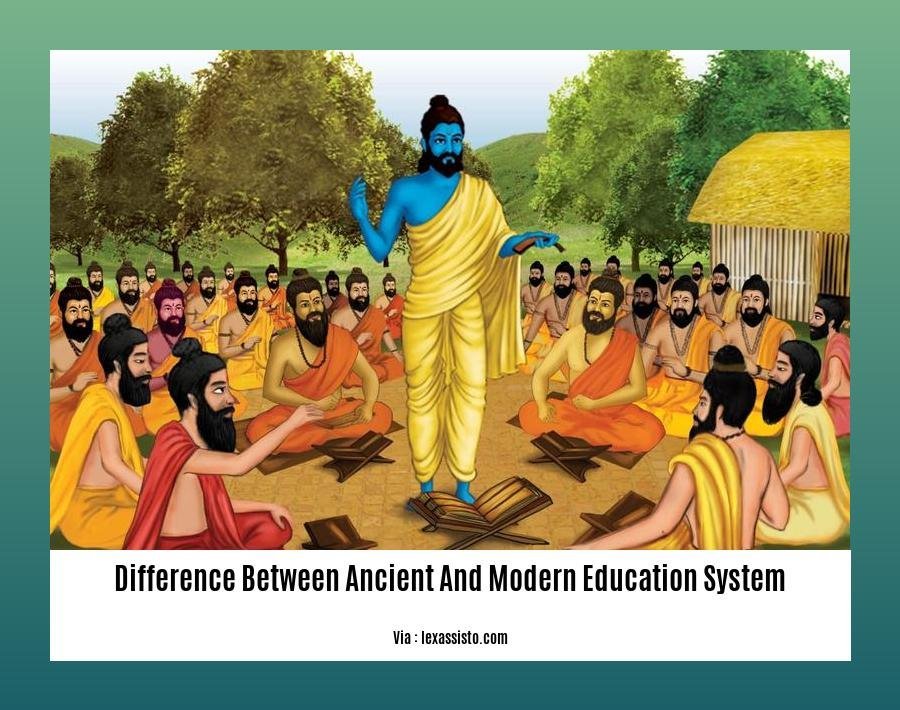
Hey folks! Let’s embark on a journey through time to explore the vast difference between ancient and modern education systems. Buckle up as we delve into the contrasting philosophies, methodologies, and societal impacts of education across the ages!
Unveiling the Ancient Blueprint:
In ancient times, education held a profound purpose: to shape individuals morally and intellectually. Picture this: students gathered around revered teachers in temples or public spaces, imbibing knowledge through lectures, discussions, and memorization. The focus was on cultivating virtues, mastering essential skills, and preserving cultural heritage.
The Modern Metamorphosis:
Fast forward to the modern era, and education has undergone a dynamic transformation. It’s no longer confined to temples or elite circles; it’s accessible to all, fostering critical thinking, problem-solving, and adaptability. Classrooms have evolved into interactive spaces where technology and hands-on experiences reign supreme.
Contrasting Methodologies:
Ancient:
– Teacher-centered approach, with the teacher as the sole source of knowledge.
– Emphasis on rote memorization and regurgitation of facts.
– Rigid curriculum, leaving little room for individual exploration.
Modern:
– Student-centered approach, recognizing the unique learning needs of each individual.
– Encourages critical thinking, problem-solving, and creativity.
– Flexible curriculum, allowing students to explore diverse interests and talents.
Impact on Society:
Ancient:
– Preserved cultural heritage and values.
– Maintained social order and stability.
– Prepared individuals for specific roles in society.
Modern:
– Empowers individuals with the skills and knowledge to navigate a rapidly changing world.
– Promotes social mobility and economic prosperity.
– Fosters a culture of lifelong learning and innovation.
A Glimpse into the Future:
As we peer into the future of education, it’s evident that technology will continue to play an integral role. Online learning, virtual reality, and artificial intelligence will further personalize and enhance the learning experience. We can expect a blend of traditional and modern approaches, striking a balance between cultural preservation and the demands of a dynamic world.
So, there you have it, folks! The difference between ancient and modern education systems is a tale of adaptation, innovation, and the ever-evolving pursuit of knowledge. From temples to classrooms, from rote memorization to critical thinking, education has come a long way. As we move forward, let’s embrace the best of both worlds, shaping a future where education empowers individuals to thrive in an ever-changing landscape.
Wondering about the contrasting traits of ancient and modern education? Difference between ancient and modern education has the answer.
Looking to uncover the disparity between the ancient and modern Olympics? Dive into Difference between ancient and modern Olympics Class 11.
Uncover the renowned ancient Greek playwrights who left an indelible mark on theater. Explore Famous ancient Greek playwrights to learn about their contributions.
Voyage through time and discover the comprehensive History of Ancient Israel Timeline. Delve into the significant events that shaped this ancient civilization.
Role of Technology in Education Throughout History
Technology has always shaped how people learn, and its impact on education has evolved alongside technological advancements. In ancient times, scribes meticulously recorded teachings on clay tablets or papyrus scrolls, serving as the primary mode of knowledge dissemination. Fast forward to today’s digital age, where virtual classrooms and interactive online platforms redefine the learning landscape.
Key Takeaways:
- Ancient Technologies:
- Clay tablets, papyrus scrolls, and handwritten manuscripts served as the primary educational tools.
- Teachers imparted knowledge through verbal instruction and demonstrations, often using physical objects or diagrams for illustration.
Technology was limited and largely confined to writing implements and basic tools for creating learning materials.
Modern Technologies:
- Digital devices, online resources, and interactive software revolutionize teaching and learning.
- Students engage with multimedia content, simulations, and virtual reality experiences.
Cloud-based platforms facilitate collaboration and resource sharing, breaking down geographical barriers.
Future of Educational Technology:
- The convergence of emerging technologies like artificial intelligence (AI), augmented reality (AR), and blockchain promises further transformation.
- AI-powered personalized learning, virtual reality simulations, and blockchain-secured educational records are just a glimpse of what’s to come.
The Ongoing Evolution
The role of technology in education is a dynamic and ever-evolving narrative. From the ancient scribes to today’s digital natives, technology continues to reshape how we teach, learn, and access knowledge. As technology advances, so do the possibilities for creating engaging and effective learning experiences.
Relevant URL Sources:
- The History of Technology in Education: A Comparative Study and Analysis
- Education technology research ancient and present: A critical analysis
Assessment and evaluation of students in ancient and modern systems:
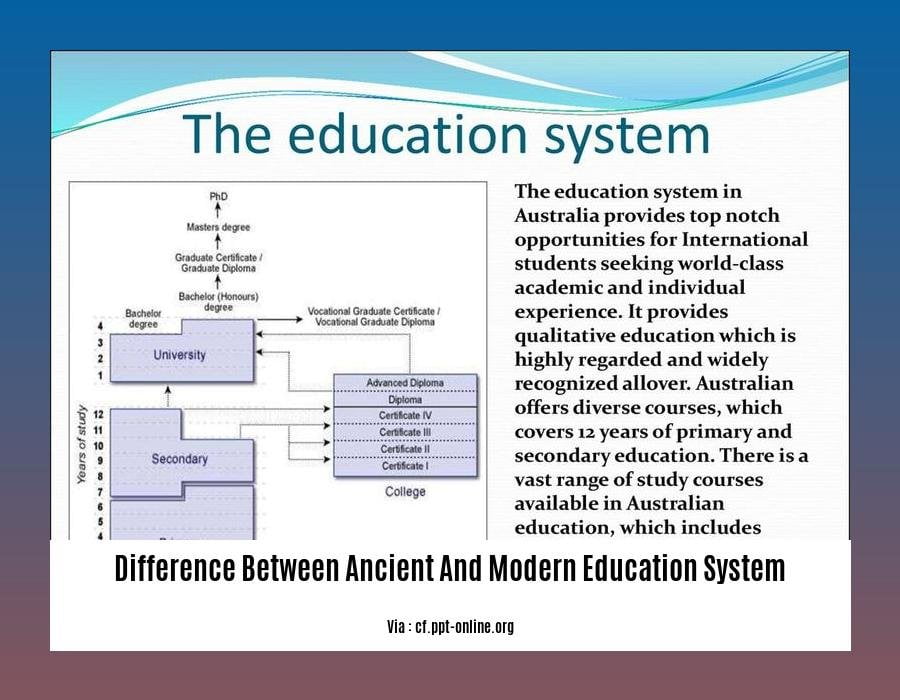
In the tapestry of education’s evolution, the methods and purposes of assessing and evaluating students have undergone profound transformations. Let’s embark on a historical odyssey, comparing ancient and modern approaches to student assessment in the Indian context.
Ancient assessments: Rooted in wisdom and moral values
In ancient India, the assessment of students was intertwined with the broader goal of shaping individuals’ character and cultivating moral values. The focus was less on quantifying academic achievement and more on evaluating a student’s overall growth, conduct, and adherence to societal norms.
- Oral Examinations:
Ancient education relied heavily on oral examinations, where students were expected to demonstrate their understanding of scriptures, texts, and philosophical concepts through verbal discussions.
Apprenticeship and Practical Assessments:
- Apprenticeship was a prevalent form of assessment, where students learned a craft or profession by working alongside skilled artisans or scholars. Their skills were evaluated based on their ability to apply knowledge in real-world settings.
Practical assessments measured students’ proficiency in specific skills, such as mathematics, astronomy, or medicine, through practical demonstrations or projects.
Teacher Observations:
- Teachers played a crucial role in assessing students’ progress. They observed students’ behavior, diligence, and commitment to learning, providing feedback and guidance to foster moral and intellectual development.
Modern assessment: Emphasizing quantifiable skills and knowledge
As education systems evolved to meet the demands of a rapidly changing world, the assessment of students shifted towards quantifiable measures of academic achievement.
- Standardized Testing:
Standardized tests became the cornerstone of modern assessment, measuring students’ knowledge and skills in specific subjects. These tests are designed to be objective and comparable, allowing for easy data analysis and comparison.
Grading Systems:
Grading systems, typically based on numerical or letter grades, were introduced to evaluate students’ performance in various subjects and assignments. Grades serve as a concise summary of a student’s academic progress.
Continuous Assessment:
Continuous assessment methods, such as quizzes, assignments, and projects, were adopted to provide ongoing feedback and track students’ progress throughout the academic term.
Portfolio Assessments:
- Portfolio assessments became popular, allowing students to showcase their work, skills, and accomplishments over time. Portfolios provide a more comprehensive view of a student’s learning journey.
Key Takeaways:
- Ancient assessments were rooted in moral values and holistic development, emphasizing conduct and practical skills, while modern assessments focus on quantifiable academic achievement and standardized testing.
- Ancient evaluations relied on oral examinations, apprenticeship, and teacher observations, while modern evaluations employ standardized tests, grading systems, continuous assessment, and portfolio assessments.
- Both ancient and modern assessments have their strengths; ancient assessments nurtured moral values and practical skills, while modern assessments provide objective and measurable data for decision-making.
Relevant URL Sources:
Social, cultural, and economic factors influencing education
Education has undergone a remarkable transformation over time, and social, cultural, and economic factors have played a significant role in shaping its evolution. Let’s dive into some key aspects that have influenced education systems across civilizations.
Social Factors:
– Cultural Beliefs: Societies’ cultural values and beliefs shape educational practices. In many traditional societies, education emphasizes respect for elders, community involvement, and the preservation of cultural heritage.
– Social Stratification: Education systems often reflect and perpetuate existing social hierarchies. Historically, access to quality education was limited to certain social classes, while others were marginalized.
– Gender Roles: The role of women in society significantly impacts their educational opportunities. In many cultures, gender biases and stereotypes influence girls’ access to education and their choice of subjects.
– Family Structure: Family dynamics and parental involvement also affect a child’s educational journey. Supportive and engaged families can positively impact a child’s learning outcomes.
Cultural Factors:
– Language and Communication: The language of instruction and the availability of educational materials in different languages impact access to education for diverse linguistic groups.
– Arts and Humanities: Cultural values and traditions influence the inclusion of arts, music, and humanities in education curricula.
– Religion: Religious beliefs and practices can shape the curriculum, values, and ethical teachings in educational institutions.
Economic Factors:
– Economic Inequality: Disparities in wealth and income can create significant educational inequalities. Children from disadvantaged economic backgrounds may face barriers in accessing quality education.
– Cost of Education: The affordability of education plays a crucial role in determining who can access higher education and advanced skills training.
– Labor Market: The demands of the labor market influence the curriculum and skills taught in educational institutions.
– Technological Advancements: Technological innovations can transform education by providing new tools and resources, but access to technology may be unevenly distributed.
Key Takeaways:
- Social, cultural, and economic factors are intertwined and influence education systems in complex ways.
- Education can perpetuate existing social inequalities or contribute to social mobility, depending on its design and implementation.
- Cultural values, beliefs, and traditions shape the content and pedagogy of education.
- Economic disparities can create barriers to accessing quality education, leading to educational inequality.
- Technological advancements have the potential to transform education by providing new tools and resources, but access to technology may be unevenly distributed.
Sources:
– Social, Cultural, and Economic Factors Influencing Education
– The Impact of Social, Cultural, and Economic Factors on Education
FAQ
Q1: How did ancient education systems differ from modern education systems in terms of teaching methods?
A1: Ancient education systems often emphasized rote memorization and teacher-centered instruction, while modern education systems prioritize critical thinking, problem-solving, and student-centered learning.
Q2: What were the primary goals of ancient education systems compared to modern education systems?
A2: Ancient education systems focused on instilling cultural values, moral principles, and practical skills, while modern education systems aim to develop critical thinking, problem-solving abilities, and adaptability to a rapidly changing world.
Q3: How did the role of technology differ in ancient and modern education systems?
A3: Ancient education systems primarily relied on traditional methods like oral storytelling and handwritten texts, whereas modern education systems extensively utilize technology for accessing information, delivering instruction, and facilitating learning.
Q4: How did ancient and modern education systems address the needs of diverse learners?
A4: Ancient education systems often catered to a limited segment of society, while modern education systems strive to provide equitable access to education for individuals from various backgrounds and abilities.
Q5: What are some challenges that modern education systems face that ancient education systems did not?
A5: Modern education systems grapple with issues such as the integration of technology, the need for continuous adaptation to evolving societal demands, and the pressure to prepare students for an uncertain job market.
- SYBAU See You Baby Meaning: Gen Z Slang Evolves - July 1, 2025
- Unlock Your Inner Youth: Lifestyle Secrets for a Vibrant Life - July 1, 2025
- Decode SYBAU Meaning: Gen Z Slang Explained - July 1, 2025
